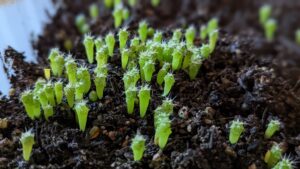As the holiday season approaches, the anticipation of vibrant blooms from the Christmas cactus fills the air with a sense of expectancy. Much like the first snowfall, these blossoms offer a spectacle that is not merely aesthetic but resonates with festivity and cheer. However, when the promise of flowers fizzles into disappointment, questions abound. Why won’t my Christmas cactus bloom? This conundrum, akin to a silent symphony turned cacophony, can be disheartening. Understanding the common culprits and solutions can help rejuvenate your holiday spirit and coax your plant back to life.
Every plant, particularly the Christmas cactus, thrives on certain conditions that harmonize its growth. When these conditions falter, blooming can wane—a dissonance akin to a musician missing their cue. Let us delve into the intricate tapestry of factors affecting the flowering of this unique succulent.
Understanding the Blooming Cycle
The first step in resolving your cactus’s blooming woes is understanding its natural blooming cycle. Unlike many houseplants, the Christmas cactus (Schlumbergera) blooms in response to the changes in day length and temperature. This phenomenon resembles the way a film premieres at a specific time, drawing anticipation from its audience. Typically, the blooming period unfolds from late fall to mid-winter, coinciding with the holiday festivities.
However, for this blooming cycle to ignite, the cactus must undergo several weeks of dormancy. During this preparatory phase, the environment must approximate its native habitat of Brazil’s jungles. It is essential to replicate the cooler temperatures (around 50-55°F or 10-13°C) and slightly reduce watering, creating a balance akin to a tightly wound spring, ready to release its energy.
Insufficient Light Conditions
Light acts as a vital nutrient that stimulates growth, just as a sunrise invigorates the day. For a Christmas cactus, inadequate sunlight can thwart blooming efforts. These cacti prefer bright, indirect light, a condition reminiscent of the dappled sunlight filtering through a forest canopy.
When placed in dreary corners or exposed to harsh direct light, your cactus may become disoriented and reluctant to bloom. Examine your cactus’s location; ideally, it should bask in the glow of a south or east-facing window, enjoying filtered light that nurtures its leafy foliage without scalding it. If natural light is scarce, consider supplementing with grow lights, a feasible solution to mimic the sun’s embrace.
Overwatering: The Hidden Peril
Watering is a delicate dance—too much and it becomes a veritable deluge, drowning the roots; too little and the plant wilts in despair. Overwatering is one of the most common pitfalls affecting the Christmas cactus, akin to a flooding river that submerges the surrounding landscape.
Well-draining soil is paramount for these succulents. When water accumulates, roots can rot, and fungal diseases can take hold, stifling the plant’s ability to bloom. Ensure that your pot has drainage holes, allowing excess water to escape like a river finding its own course. Allow the top inch of soil to dry out before re-watering, striking a balance that encourages healthy root development. Fertilization during the growing season can also contribute, but do so sparingly to avoid nutrient burn.
Pests: Uninvited Guests
Much like an unexpected storm can disrupt a serene day, pests such as mealybugs and spider mites can wreak havoc on your cactus. These unwanted guests often attach themselves to the leaves and stems, siphoning vital nutrients and weakening the plant. Their presence can be a silent foe, as the blooms fade with the stress imposed by these intruders.
Regularly inspect your cactus, looking for telltale signs of infestation. Treat infestations with insecticidal soap or neem oil, administering a thorough wash to dislodge these nuisances. Maintaining a clean environment that promotes air circulation can deter pests from taking residence in the first place.
Temperature Fluctuations: The Subtle Saboteur
Temperature fluctuations can be as disorienting for a cactus as a sudden change in rhythm for a dancer. These plants thrive in stable conditions; drastic temperature changes can prompt stress, manifesting in a refusal to bloom. Ideally, the Christmas cactus prefers temperatures between 60-70°F (15-21°C) during the growing season and cooler conditions during dormancy.
Be mindful of drafts from windows or heating vents, which can impact your cactus’s comfort. Establish a nurturing habitat by ensuring a consistent and moderate temperature that encourages blooming without the stressors of abrupt changes.
Conclusion: Patience and Care Lead to Blooms
In the end, nurturing a Christmas cactus to bloom is an exercise in patience and attentiveness. Just as every artist requires time to perfect their craft, so too does your cactus require a delicate balance of light, water, temperature, and care. By understanding the fundamental needs of this exquisite plant, you can cultivate an environment in which it flourishes—transforming your home into a tapestry of vibrant holiday cheer. So, as you navigate the challenges of cactus care, remember that each bloom is not just a flower; it is a celebration of life, resilience, and the magic of the season.





Leave a Comment